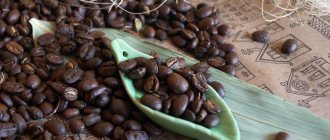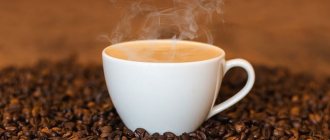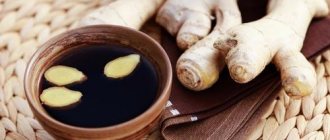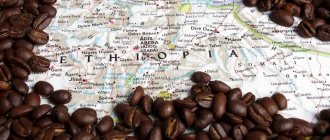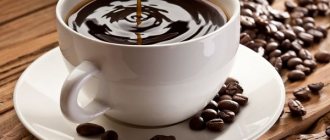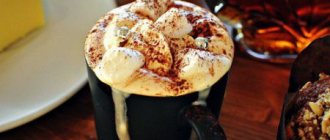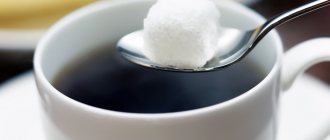Vitamins
Coffee with condensed milk contains the following beneficial vitamins:
Vitamins are essential micronutrients. They do not provide energy, but are vital for the normal functioning of the body and maintaining health. To get a variety of vitamins, you should eat foods from all food groups
| Vitamin | Meaning |
| Vitamin B1 (thiamine), mg | 0.04 |
| Vitamin B2 (riboflavin), mg | 0.2 |
| Vitamin B6 (pyridoxine), mg | 0.05 |
| Vitamin B9 (folic), mcg | 5 |
| Vitamin C, mg | 1.5 |
| Vitamin E (TE), mg | 0.09 |
| Vitamin PP (Niacin equivalent), mg | 0.598 |
| Vitamin B12 (cobalamins), mcg | 0.4 |
| Vitamin D, mcg | 0.05 |
| Vitamin A, mg | 0.05 |
| Choline, mg | 23.6 |
| Vitamin A (VE), mcg | 50 |
| Vitamin B5 (pantothenic), mg | 0.4 |
| Vitamin PP, mg | 0.1 |
| Vitamin H (biotin), mcg | 3.2 |
How many calories are in coffee with condensed milk?
Nutritional value and chemical composition of “Instant coffee with condensed milk.”
The table shows the nutritional content (calories, proteins, fats, carbohydrates, vitamins and minerals) per 100 grams of edible portion.
| Nutrient | Quantity | Norm** | % of the norm in 100 g | % of the norm in 100 kcal | 100% normal |
| Calorie content | 24.7 kcal | 1684 kcal | 1.5% | 6.1% | 6818 g |
| Squirrels | 0.6 g | 76 g | 0.8% | 3.2% | 12667 g |
| Fats | 0.6 g | 56 g | 1.1% | 4.5% | 9333 g |
| Carbohydrates | 4.2 g | 219 g | 1.9% | 7.7% | 5214 g |
| Water | 94 g | 2273 g | 4.1% | 16.6% | 2418 g |
| Ash | 0.284 g | ~ | |||
| Vitamins | |||||
| Vitamin A, RE | 3.3 mcg | 900 mcg | 0.4% | 1.6% | 27273 g |
| Retinol | 0.003 mg | ~ | |||
| beta carotene | 0.002 mg | 5 mg | 250000 g | ||
| Vitamin B1, thiamine | 0.004 mg | 1.5 mg | 0.3% | 1.2% | 37500 g |
| Vitamin B2, riboflavin | 0.027 mg | 1.8 mg | 1.5% | 6.1% | 6667 g |
| Vitamin B4, choline | 2.09 mg | 500 mg | 0.4% | 1.6% | 23923 g |
| Vitamin B5, pantothenic | 0.057 mg | 5 mg | 1.1% | 4.5% | 8772 g |
| Vitamin B6, pyridoxine | 0.009 mg | 2 mg | 0.5% | 2% | 22222 g |
| Vitamin B12, cobalamin | 0.035 mcg | 3 mcg | 1.2% | 4.9% | 8571 g |
| Vitamin C, ascorbic acid | 0.07 mg | 90 mg | 0.1% | 0.4% | 128571 g |
| Vitamin D, calciferol | 0.003 µg | 10 mcg | 333333 g | ||
| Vitamin E, alpha tocopherol, TE | 0.014 mg | 15 mg | 0.1% | 0.4% | 107143 g |
| Vitamin H, biotin | 0.223 mcg | 50 mcg | 0.4% | 1.6% | 22422 g |
| Vitamin RR, NE | 0.3451 mg | 20 mg | 1.7% | 6.9% | 5795 g |
| Niacin | 0.014 mg | ~ | |||
| Macronutrients | |||||
| Potassium, K | 53.37 mg | 2500 mg | 2.1% | 8.5% | 4684 g |
| Calcium, Ca | 25.14 mg | 1000 mg | 2.5% | 10.1% | 3978 g |
| Magnesium, Mg | 6.09 mg | 400 mg | 1.5% | 6.1% | 6568 g |
| Sodium, Na | 12.79 mg | 1300 mg | 1% | 4% | 10164 g |
| Sera, S | 4.88 mg | 1000 mg | 0.5% | 2% | 20492 g |
| Phosphorus, P | 18.1 mg | 800 mg | 2.3% | 9.3% | 4420 g |
| Chlorine, Cl | 16.6 mg | 2300 mg | 0.7% | 2.8% | 13855 g |
| Microelements | |||||
| Iron, Fe | 0.051 mg | 18 mg | 0.3% | 1.2% | 35294 g |
| Yod, I | 0.49 mcg | 150 mcg | 0.3% | 1.2% | 30612 g |
| Cobalt, Co | 0.14 mcg | 10 mcg | 1.4% | 5.7% | 7143 g |
| Manganese, Mn | 0.0145 mg | 2 mg | 0.7% | 2.8% | 13793 g |
| Copper, Cu | 12.33 mcg | 1000 mcg | 1.2% | 4.9% | 8110 g |
| Selenium, Se | 0.302 mcg | 55 mcg | 0.5% | 2% | 18212 g |
| Fluorine, F | 2.44 mcg | 4000 mcg | 0.1% | 0.4% | 163934 g |
| Zinc, Zn | 0.0791 mg | 12 mg | 0.7% | 2.8% | 15171 g |
| Digestible carbohydrates | |||||
| Mono- and disaccharides (sugars) | 3.9 g | max 100 g | |||
| Lactose | 0.872 g | ~ | |||
| Sucrose | 3.035 g | ~ | |||
| Essential amino acids | 0.198 g | ~ | |||
| Arginine* | 0.017 g | ~ | |||
| Valin | 0.032 g | ~ | |||
| Histidine* | 0.012 g | ~ | |||
| Isoleucine | 0.029 g | ~ | |||
| Leucine | 0.038 g | ~ | |||
| Lysine | 0.038 g | ~ | |||
| Methionine | 0.012 g | ~ | |||
| Methionine + Cysteine | 0.016 g | ~ | |||
| Threonine | 0.021 g | ~ | |||
| Tryptophan | 0.007 g | ~ | |||
| Phenylalanine | 0.022 g | ~ | |||
| Phenylalanine+Tyrosine | 0.046 g | ~ | |||
| Nonessential amino acids | 0.315 g | ~ | |||
| Alanin | 0.016 g | ~ | |||
| Aspartic acid | 0.037 g | ~ | |||
| Glycine | 0.01 g | ~ | |||
| Glutamic acid | 0.111 g | ~ | |||
| Proline | 0.054 g | ~ | |||
| Serin | 0.029 g | ~ | |||
| Tyrosine | 0.024 g | ~ | |||
| Cysteine | 0.005 g | ~ | |||
| Sterols (sterols) | |||||
| Cholesterol | 2.09 mg | max 300 mg | |||
| Saturated fatty acids | |||||
| Saturated fatty acids | 0.4 g | max 18.7 g | |||
| 16:0 Palmitinaya | 0.001 g | ~ | |||
| Monounsaturated fatty acids | 0.18 g | min 16.8 g | 1.1% | 4.5% | |
| 18:1 Oleic (omega-9) | 0.172 g | ~ | |||
| Polyunsaturated fatty acids | 0.024 g | from 11.2 to 20.6 g | 0.2% | 0.8% | |
| 18:2 Linolevaya | 0.014 g | ~ | |||
| 18:3 Linolenic | 0.004 g | ~ | |||
| 20:4 Arachidonic | 0.006 g | ~ | |||
| Other substances | |||||
| Caffeine | 24.186 mg | ~ |
Micro and Macroelements
Coffee with condensed milk contains the following micro and macro elements:
These substances are one of the main nutritional factors that affect health, performance and active longevity. The body does not produce micro and macro elements and therefore must receive them in finished form, for example, with food.
| Micro- and macroelements | Meaning |
| Water, city | 80 |
| Sodium, mg | 50 |
| Potassium, mg | 146 |
| Phosphorus, mg | 90 |
| Magnesium, mg | 14 |
| Calcium, mg | 120 |
| Sulfur, mg | 29 |
| Copper, µg | 12 |
| Aluminum, µg | 50 |
| Strontium, mcg | 17 |
| Iodine, mcg | 9 |
| Manganese, mg | 0.006 |
| Chromium, µg | 2 |
| Fluorine, mcg | 20 |
| Molybdenum, mcg | 5 |
| Cobalt, µg | 0.8 |
| Selenium, mcg | 2 |
| Tin, µg | 13 |
| Zinc, mg | 0.4 |
| Iron, mg | 0.07 |
| Chlorine, mg | 110 |
Users also search for:
Application
Coffee has been enjoyed with pleasure for several centuries. It is worth remembering that it is better to drink coffee in the morning - the drink will give you the boost of energy necessary for productive activities.
According to the Eastern tradition of drinking coffee, you need to drink a coffee drink after a hearty breakfast. Because coffee drunk on an empty stomach can harm the body. Confectioners and producers of alcoholic beverages enjoy using aromatic coffee beans, which makes their products especially memorable and popular.
Market Analytics
- Global cosmetics market 2021: an unprecedented test for the global cosmetics industry
- Top 10 Cosmetic Research and Development of 2021
- 2020 in the beauty industry – innovation without borders
Convenient search for beauty salons on our website
Beauty salons in Moscow Beauty salons in St. Petersburg Beauty salons in Ekaterinburg Beauty salons in Novosibirsk
Latest blog posts on our website
- Naturecream / Esterified oils
- Naturecream / Arnica - the magical plant of alchemists
- Naturecream / Tremella Extract - Snow Mushroom Detox for Skin
- Prostye-sovety / How to visually enlarge your lips with makeup
- Naturecream / Apricot kernel oil for face
- Naturecream / MATRIXYL3000 - the best skin elasticity stimulator
- Naturecream / SPF in Natural Oils
- Naturecream / Geranium (Pelargonium) oil for skin health and beauty
- Prostye-sovety / Save on a beauty salon: procedures that can be done at home
- Naturecream / Growth Factor - brings back youth?
Latest forum topics on our website
- Natalya / How to properly make a gelatin mask?
- Mrs._Smith / Badly sunburned! What to do?((
- Ice / Is it necessary to combine fitness classes with a diet?
- Antonova / What can be used for hair loss?
- Radio operatorKat / Who was on a protein diet?
Other articles in this section
| Orange juice China is considered the birthplace of the orange, where these fruits have been collected and used for food and treatment for a long time. From China, this fruit spread to the countries of the East. It appeared in Europe quite late, only at the beginning of the 16th century. |
| Coffee with Condensed Milk and Sugar Coffee is believed to have been discovered in 850 AD. But coffee received its full calling much later, after several centuries. At first, it was not the coffee beans themselves that were consumed, but only the coffee berries. This drink was used as a tonic. Somewhat later, in Yemen, the drink began to be prepared from ripe dried coffee fruit, or rather its pulp. This is the famous “white Yemeni coffee”, also called “geshir” or “kishr”. |
| Watermelon juice Beloved by most, this unusual melon crop, which appears in our country in the second half of summer, originally grew in southern Africa. There you can still find a wild type of watermelon, which is considered the ancestor of the cultivated one. Since the times of Ancient Egypt, watermelon has been cultivated. It was used not only for food, but also as a medicine. In Europe, watermelons were introduced during the Crusades. |
| Apricot juice Apricot juice is a drink made from the fruits of the apricot tree. The fruits of this tree have been known to people for quite a long time and are widely used both fresh and for preparing various jams, preserves, compotes, and alcoholic beverages. Apricot juice is prepared mainly with pulp, so it retains most of its beneficial properties. Sometimes sugar is added to it, which naturally reduces the nutritional value of this product. |
| Plum jam jelly There are many recipes from fruits, berries, juices, jams, various cereals and milk for preparing such a tasty and healthy dish as jelly. The recipe for its preparation dates back approximately ten centuries, and in ancient times it was not prepared and served as a sweet dish. Only with the advent of starch did they begin to prepare fruit and berry jelly. It is not difficult and can be prepared quickly, and nutritionists recommend its regular use not only as a prevention of certain diseases, but also in the treatment of the gastrointestinal tract and improvement of intestinal microflora. Of course, adding different ingredients to jelly changes the chemical composition and amount of vitamins and microelements in this dish. Plum jam jelly perfectly combines the necessary benefits and a wonderful aromatic taste. |
| Rooibos tea (rooibos) dry Belongs to the category of herbal teas, since the source of raw materials is not a tea tree leaf. Rooibos tea is obtained from the shrub of the same name, which is native to the Cederberg Mountains in South Africa. |
| Kissel from dried apples Some of the first mentions of jelly made from dried apples date back to the end of the 1st millennium AD. Everyone knows that apples are very useful for the normal functioning of the human body. However, apples cannot be stored for a long time and lose the vitamins they contain. The way out of this situation was the use of dried apples. You can use dried apples in making jelly. It turns out a very tasty and healthy jelly from dried apples, containing many vitamins and macroelements. |
| Pumpkin juice Currently, there are more than ten types of pumpkins in the world, and some of them are perennial, decorative, and even inedible! In this article we will talk about the juice of an ordinary pumpkin, which contains a whole storehouse of vitamins. |
| Mocaccino coffee This wonderful coffee drink was created in America. It is used in European countries under the name “mocaccino”, and in the USA it is called “mocha”. Coffee in its simplest form consists of adding milk and melted chocolate or cream. |
| Cocoa mass Cocoa mass is ground cocoa beans (cocoa nibs), which have previously undergone fermentation, drying and roasting. During the grinding process, cocoa beans begin to melt under the influence of temperature and form cocoa butter. An indicator of the efficiency of grinding cocoa beans is the viscosity value. The smaller it is, the more fully the cocoa butter is isolated and the easier it is to further use the grated cocoa. The rainforests of South America are traditionally considered to be the birthplace of cocoa. |
Per 100 g of product*
| % of daily value** | ||
| Belkov | 2.36 g | 3 % |
| Zhirov | 3.56 g | 4 % |
| Carbohydrates | 9.59 g | 3 % |
| Calorie content | 79.93 kcal(334 kJ) | 3 % |
| *The average value of nutritional data from various sources is given. Depending on the origin of the product, it may differ from the actual one. | **Values are based on a diet based on 2000 kcal/day |
Calories in a cup of coffee with milk
Many people like adding milk. But with such an additive, even low-calorie Americano becomes dangerous for the figure. Please note that 100 grams of the drink has 58 calories, and a regular mug (250 ml) has about 145. The larger the Americano mug, the more calories.
Americano with milk is rarely drunk without sugar, increasing the calorie content significantly with this component. Drinking it while on a diet is definitely not recommended; it does not promote weight loss. Americano with milk and a bite with buns is perfect for consumption after exhausting sports exercises to restore lost strength.
Latte
A latte consists of espresso, milk and foam. Latte differs from a regular Americano with milk in its coffee base and serving method. The most high-calorie ingredient on this list is milk, so the “weight” of a latte mug directly depends on its quantity. A standard latte contains about 250 kcal, without adding a packet of sugar. By decreasing or increasing the amount of milk in a latte, you can regulate the number of calories, but changing the standard proportions will entail a change in the usual taste.
Cappuccino
This drink of Italian origin includes espresso and some high-calorie ingredients. First of all, this is cream (milk). The milk foam that covers the surface of a cappuccino is usually frothed from full-fat milk. To enhance the taste, add one or two spoons of sugar. Therefore, such a cappuccino cannot have a low calorie content, given the constituent elements.
A cup of cappuccino has a volume of 150–180 grams. The approximate ratio of frothed milk to coffee (usually espresso, less commonly Americano) is six to one. A standard serving contains about 150 grams of milk and 30 grams of espresso. Two spoons of sugar – another plus 40 kcal. In total, a serving contains approximately 208–210 kcal. Cappuccino is not the best choice if you are hoping to lose weight.
- Treatment of intracranial pressure in adults with drugs and folk remedies
- Personal hygiene rules that are important for your health
- Red bean salad: recipes with photos
Mocaccino
Mocaccino differs from latte in that the former also contains chocolate or chocolate syrup. This component makes the drink a little piquant and gives it originality. There are mocaccino recipes that also require the addition of caramel, which eliminates the need for a spoonful of sugar. The greatest influence on the calorie content of mocaccino is the amount and type of chocolate, followed by milk, caramel or sugar. A standard serving of mocaccino has an average of 289 kcal.
